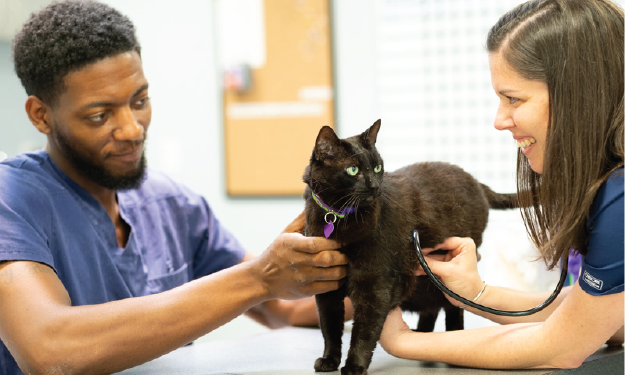The Use of CT Scans of the Lungs in Oncology

CT is considered the gold standard thoracic imaging approach for cancer patients. CT has two primary advantages over X-rays:
- CT is more sensitive. CT is able to consistently detect small nodules in the lung1. This increases our opportunity to define and detect cancers early in the course of progression.
- CT is less prone to error. An important advantage of CT over survey X-rays relates to the fact that it provides a 3-dimensional, rather than 2-dimensional image. This eliminates the challenge of interpreting superimposed anatomical structures which can make interpreting X-rays difficult.2
Computed tomography is recommended as a routine screening test for those human patients in which the finding of pulmonary or intra-thoracic lymph node metastases would have an impact on patient management and decision-making. In our veterinary patients, CT has been used only sparingly for this purpose. Obstacles that have limited the use of this valuable imaging approach in veterinary medicine has been the additional expense for CT over x-ray, the need for anesthesia, and decreased availability of this superior imaging approach.
Additional Background
Although survey thoracic radiography has historically been a useful modality for evaluating the thoracic cavity of veterinary patients; limitations exist as to its sensitivity in detecting pulmonary nodules. Specifically, radiographic techniques are able to detect nodules greater than or equal to 5mm in diameter; intuitively, metastatic lesions in their early phases are likely to be smaller than this threshold. Conversely, computed tomography is able to detect pulmonary nodules as small as 1-2mm in diameter. In a recent study3, 64% of dogs evaluated had pulmonary nodules or masses detected on CT. Of the dogs that had positive CT findings, only 81% of those had pulmonary nodules or masses detected on radiographs, demonstrating the superior ability of CT to detect abnormalities in the lungs. Naturally, the accurate detection of pulmonary metastatic lesions is crucial to the management of our veterinary oncology patients, as this finding has implications toward whether a more aggressive definitive therapeutic plan is elected versus the selection of a more palliative approach.
Another valuable use of CT is for the evaluation of dogs and cats with primary lung tumors. Known prognostic factors for dogs with primary lung tumors include tumor size and location, tracheobronchial lymphadenopathy, and the presence of pulmonary metastasis.4 Along with the detection of both pulmonary and lymph node metastases, CT is valuable to more precisely determine the location and extent of lung tumors, so that the decision to pursue major surgical intervention has the best chance of success, and in many cases of primary lung tumors, a long-term, potentially curative outcome. This same rationale can be applied to dogs and cats with head and neck tumors.
Although with increased sensitivity comes an increase in the rate of false positive findings (resulting from over-interpretation of end-on vessels and other benign pulmonary lesions), the ability of CT to evaluate these structures in 3D can aid in the differentiation of benign versus malignant lesions.
The future of veterinary oncology centers around the concept of personalized medicine, where diagnostic and therapeutic plans are specifically tailored to a patient’s individual history, clinical signs, and basic diagnostic test findings in order to determine the most appropriate course of action. Arming doctors and owners with the most complete clinical picture as possible is of fundamental importance to this state-of-the-art care. By thoroughly staging our patients with thoracic CT, more informed choices regarding invasive procedures such as amputation or thoracotomy can be made. It is these major decisions that influence both the short and long term outcomes for our veterinary oncology patients. Thoracic computed tomography, along with other advanced diagnostics including ultrasound, MRI, PET, and specialized tumor evaluation (special stains, genetic mutation tests), are now readily available to individualize and improve the care of our companion animals with cancer.
Citations
- Davis SD. CT evaluation for pulmonary metastases in patients with extrathoracic malignancy. Radiology 1991;180:1–12.
- Prather AB, Berry CR, Thral DE. Use of radiography in combination with computed tomography for the assessment of noncardiac thoracic disease in the dog and cat. Vet Radiol Ultrasound. 2005 Mar-Apr;46(2):114-21.
- Armbrust LJ, Biller DS, Bamford A, Chun R, Garrett LD, Sanderson MW. Comparison of three-view thoracic radiography and computed tomography for detection of pulmonary nodules in dogs with neoplasia. J Am Vet Med Assoc. May 2012; 240(9):1088-94.
- Paoloni MC, Adams WM, Dubielzig RR, Kurzman I, Vail DM, Hardie RJ. Comparison of results of computed tomography and radiography with histopathologic findings in tracheobronchial lymph nodes in dogs with primary lung tumors: 14 cases (1999-2002). J Am Vet Med Assoc. June 2006;228(11):1718-1722.